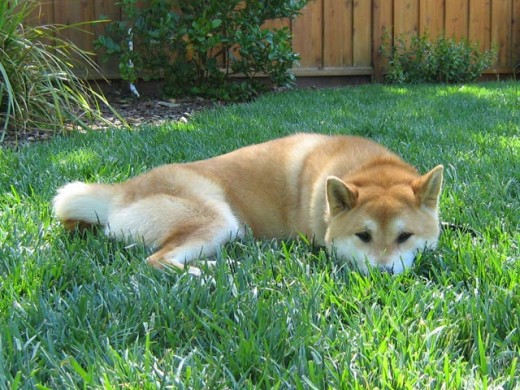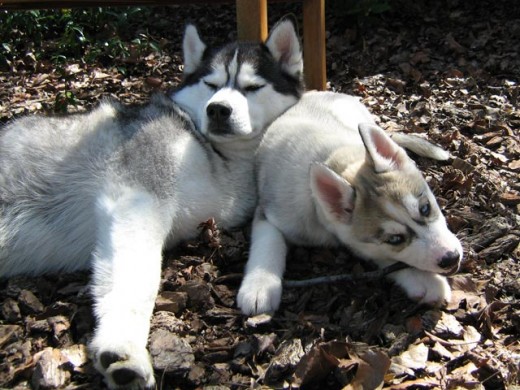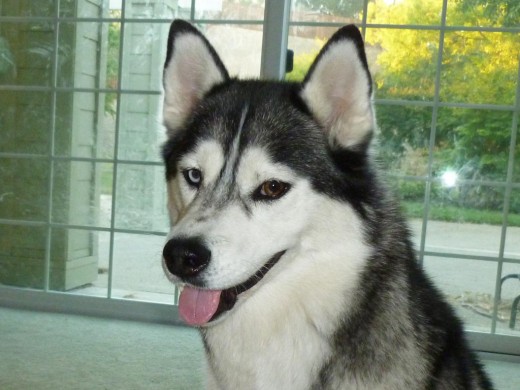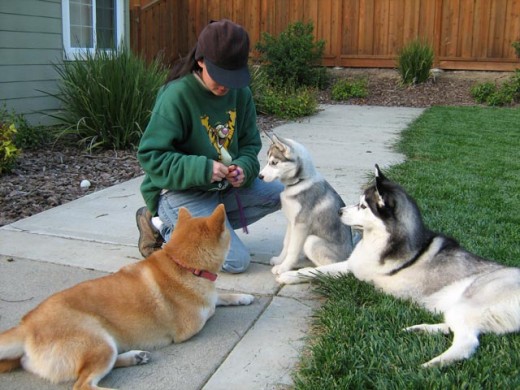Like us, dogs have anxieties and fears. A dog’s anxieties, may not be the same as our own anxieties, but they cause stress and physical reactions just the same.
Some common dog anxiety problems include –
- Separation anxiety – A dog gets anxious when left alone.
- Noise anxiety – A dog becomes fearful when exposed to loud or unusual noises. Some examples include fireworks, thunderstorms, garbage trucks, and more.
- Travel anxiety – The car is like a den, but dogs are unaccustomed to moving dens. Therefore, they may become unsure and stressed over something so new and unexpected.
- Confinement anxiety – A dog gets anxious when he feels trapped or confined. If a threat should arise, a confined dog may be unable to escape or flee.

Symptoms of Dog Anxiety

When dogs are anxious, they may engage in repetitive or displacement behaviors to relieve their stress. For example, when we are anxious, we may pace, bite our nails, or play with our hair.
Dogs may also pace, groom, and more. Some dog anxiety behaviors may lead to property destruction, may cause us harm, or may simply be undesirable to our human sensibilities. This may include –
- Non-stop barking.
- Chewing up furniture, walls, shoes, garbage, and anything else in sight.
- Pooping and peeing in the house, crate, or other confinement area.
- Eating his own poop.
- Aggression toward people, dogs, or other animals.
Punishment or aversive techniques will do little to stop these anxious dog behaviors in the long-run, because punishment does not address the source of the problem, which is the dog’s anxiety. In fact, suppression of these displacement behaviors, through pain and dominance methods, will make the problem worse, because pain increases stress and uncertainty.
Below are some common ways on how to deal with dog anxiety.

1. Desensitization Exercises

One of the best ways to help a dog deal with his anxiety issues, is by slowly desensitizing him to the problem stimulus.
In the desensitization process, we start with a weak version of the stimulus that is triggering the anxiety attack.
The stimulus must be weak enough, so that my dog is able to stay calm in its presence. Then, I get him to focus on me, by doing eye-contact commands or simple obedience exercises.
If my dog is able to focus and stay in-control, I reward him with a very high priority treat. For desensitization purposes, I usually bust out the really good stuff. I try to pick a highly aromatic or smelly treat that my dog loves, but does not usually get to eat. The smell will help to engage his nose, and further distract him from the source of his anxiety.
When he is comfortable with this exercise, is calm, and able to follow simple commands, I very slowly raise the strength of the problem stimulus. I make each session short, fun, and very rewarding.
In this way, my dog learns alternative behaviors for dealing with stressful situations. He also learns to associate something that was previously a source of fear and stress, with something positive (nice smells, yummy treats), and with being calm.

2. Calm Environment

Another important aspect of helping an anxious dog, is to create a calm and predictable environment for him, in his daily life.
- Fixed routine – I set a fixed schedule for feeding, walking, play-time, leaving the house, coming home, and more. I also establish a fixed set of rules, and a consistent way of enforcing them. A very fixed routine and rule-set, helps our dog understand what to expect from us, and also what we expect from him in return. Greater certainty reduces anxiety and stress.
- Staying calm – Most dogs are very good at picking up the energy of the people around them. My Shiba Inu, for example, is very sensitive to what I am feeling. If I get stressed and anxious, he picks up on that immediately and becomes anxious himself; but with a hundred times more gusto! Therefore, it is important for us to stay calm and in-control.
- Relaxing massage – Some trainers suggest giving our dog a massage to help him relax. There is also the special TTouch massage method, which uses circular finger motions to help relax our dog’s body.
I tried the TTouch method briefly on my Shiba Inu, but it did not seem to have much of an effect on him. Desensitization exercises, together with a fixed routine and consistent rules, helped us most.

3. Calming Equipment
There are a variety of products designed to help calm our dogs. The attraction of such products, is that they require little to no work from us. However, it is also unclear how effective they truly are.
a) Dog Appeasing Pheromone (DAP)
DAP is a synthetic chemical that was developed based on a hormone produced by nursing mother dogs. Mother dogs produce this hormone to help their puppies feel calm and secure. It also helps the mother dog establish a positive bond with her puppies.
Scientific studies *do* show that DAP has a positive effect on puppies. However, it is unclear whether DAP helps with anxiety problems in adult dogs.
There are also a variety of natural calming scents, including lavender, and other herbal remedies.

b) Dog Calming Music
“Music has charms to soothe a savage breast, To soften rocks, or bend a knotted oak.”
~~[William_Congreve]
Music can certainly help calm us down and soothe our nerves. Therefore, it is not such a big stretch to imagine that it can also be helpful to our dogs. However, the wrong kind of music can actually increase anxiety in dogs.
What is the right kind of dog music?
According to sound researcher Joshua Leeds,
“Rock music, jazz, heavy metal made them more anxious. Classical slowed them down. It just relaxed them in a way that the other music seemed to irritate them.”
~~[Want to Calm Fido Down? Try Music!]
The Thundershirt looks like a dog winter coat. It wraps around the torso of a dog, and works by exerting constant pressure on the dog’s body. Proponents argue that this pressure, can have a calming effect on the dog’s nervous system.
However, the only study I found was a very limited experiment, from an unsubstantiated source. Therefore, it is unclear whether the claims made on the effectiveness of Thundershirts are true.
Note – Pressure wraps will not work on all dogs. Some dogs may get even more anxious, when they experience continuous pressure on their body. In addition, it is unlikely that pressure wraps can fully solve our dog’s anxiety issues. Wraps and other calming equipment, are commonly used together with desensitization and other dog behavior modification techniques, to achieve true long-term success.
Depending on the dog and the situation, you may need to incorporate training with the cape to show an effect. The Anxiety Wrap recommends an 11-step treatment program for separation anxiety that includes using the wrap and leaving toys filled with favorite food treats for the dog to enjoy while you are gone.
Some people also use clocks or heartbeat pillows, to help calm new puppies.

4. Medication
Do not medicate your dog with over-the-counter human drugs, on your own. Dogs have very different physiology than humans, and dosage is very dependent on weight.
I always consult with my vet before giving my dog any medication.
Some medications used to suppress a dog’s anxiety response include –
- Clomipramine(Anafranil) – This drug was originally developed to treat OCD in humans. With dogs, it is sometimes prescribed to treat OCD and separation anxiety issues.
- Fluoxetine(Prozac,Sarafem,Fontex) – Fluoxetine is perhaps most well-known by its tradename Prozac. Prozac is used to treat heavy depression, OCD, and serious eating disorders (Bulimia nervosa) in humans. Eli Lily makes a special Prozac for dogs called Reconcile.
For lonely dogs with separation anxiety, Eli Lilly brought to market its own drug Reconcile last year. The only difference between it and Prozac is that Reconcile is chewable and tastes like beef.
- Sedatives – Powerful sedatives such as benzodiazepine (benzo) are prescription only. Some lighter sedatives such as antihistamines (Benadryl) and valerian can be obtained as over-the-counter medications for humans. Do not give sedatives or any other medication to dogs, without first consulting with a veterinarian.
The dog medication business is now a very profitable enterprise, and there are a large number of dog drugs available for purchase. These medications treat anything from separation anxiety, OCD, and depression, to motion-sickness, forgetfulness, and obesity. Most dog medications are short term solutions and may have serious side effects.

Dog Anxiety Problems
I believe that the best way to help our dogs with their anxiety issues, is through desensitization, as well as a calm and relaxed home environment.
Dog calming equipment and medication are very tempting solutions, because they involve little to no effort from us. However, their long-term effectiveness is highly questionable. These methods work by suppressing or muting the effects of anxiety, rather than addressing the source of the anxiety itself.
This is in contrast with desensitization and home management techniques, which target the anxiety stimulus, and teaches the dog new ways to cope with fear and stress. Rather than just suppressing symptoms, desensitization helps to build a dog’s confidence, and promotes a stronger bond between him and his human companions.
Ultimately, behavior modification and desensitization techniques lead to long-lasting effects, and a better quality of life for a dog and his family.


I have a 2 year old Jack Russel mix I rescued at 3 Weeks old from a dumping off a county road. He started chasing his tail aggressively when touched or when something loud happens or when another dog gets close. I have read and read about how to help him and excerise and playing aren’t helping any. I want to take him to vet to talk about medications to help, but he is so young to be put on a long term option like that so I am still searching for help.
I also have problems with grooming, baths, nail clipping, or if I have to doctor anything. He goes crazy. I am his person it seems so he isn’t so bad with me and we power threw it but it’s so exhausting … any advice???
hi. we have a German Shepard , Rex he has been a great dog, we play, wrestle and have generally a great time, he also has basic training towards being an service dog. for 3 years he has always been a very happy pal. for some reason he is not terrified of noises, rustling paper,stove timers storms and very bad separation anxiety , plus many noises. He is healthy , well fed and no illnesses. We moved into this home 1 year ago , still in Florida, beautiful home , huge fenced in yard. i bought him a pug 2 years ago, his best buddy she is O.K. but i have no clue as what to do. PLEASE HELP. JOE
How to sensibly buy LEGAL and best quality cbd products for my dog? I’ve heard how CBD dog treats could benefit your dog; reduce seizures, anxiety, pain etc.
I have a 11 year old lab mix who has such a sweet deposition. We have been very luck with him as he has been so good adjusting to anything life throws at him. We rescued him when he was about 9 months old. My husband and I both now work out of the home and have for almost 10 years. We had my daughter 6 years ago and my son 4 years ago. He started showing some different behavioral changes about a year ago. First it was when my husband was gone for work. He would at first just lie around and not interact much with us making me worry about depression. I worried what he was like when I wasn’t home so started having him go to my sister’s home during the day to give him company as she is home all day. He seemed to adjust well to this and perked up but started pacing about 6 months ago. We had him checked out to see if pain was an issue and he was put on glucosamine for some arthritis. His pacing has not seemed to get better but actually increase now to all the time. He is underfoot and will not leave our sides. The vet seems to feel it is more just his age and getting older and encourages his being brought to my sisters and good routine. We have had this in place for quite a while but he continues to pace constantly. Any suggestions to help his anxiety. Thanks.
I had adopted an american bull dog mix 6 months ago after taking him to the vet we found out that he is 5-6yrs old and 105lbs. At the time he shaked constantly and the vet said that it may just be from the stress of the shelter. 6 months later the shakes are still here. He is terrified of thunder, childern playing, pretty much any type of noise, and even bubbles. We had tried to put him in the crate when we leave but he will demolish the crate if left alone in it and im more worried about him hurting him self while destroying the crate. So we have been leaving him out in the living room most of the time he doesnt tear anything up but when he does its furniture or blinds. I can’t leave him outside unattended as he will find anyway to escape our fenced in yard. He is such a lazy lovable dog you would never think he would act out the way he does when we are not around luckily me and my husband have worked our schedules out to atleast one of us being home with him 95% of the time. But this isnt always going to work for us. We have tried sweaters/ wraps he will just rip them off. Any suggestions are appreciated!
I have a lovely 9 month cocker spaniel. He’s gentle and loving, I’ve has him for 3 months. Our problem is he is totally in love with me! He’s not inteeeested in rest of the family or anyone else. They feed him and try and walk him but it names no difference. He cries the whole walk if they take him. He’s happy on walks with me. I just don’t know what else to do. Husband and sons get upset that the dogs not happy with them. What else Can I do?
Hi,I’m hoping you can help me as I’m at my wit’s end…my Vizsla Jack is 3 yes old,we adopted him from a private rescue shelter may 2016.
We are Jack’s 4th family and right from the start he showed signs of depression & slight anxiety which we put down to him being in a new environment with strangers both human & other furbabies.(we also have rescued 2 cats a horse a pitbull and we also have a Pomeranian)
He settled in and seemed to accept his new home & family then we discovered he has a phobia to thunder,gunshot & fireworks where he gets a radical heartbeat heavy panting & severe salivating.
I thought as time passed he would gradually get better but he is getting worse to the extent that now he will self mutilate to escape even when I’m home…please help me.
Hi,
I have a 8 year old male Shiba Inu and a 10 year old female Malamute. The Shiba is generally wonderful, but for the past week has been displaying anxious behavior every night at about the same time (pacing, scratching at the door). Treats and calm petting have not helped and the only thing that calms him down is being outside on his runner.
I have no idea why he has started to act this way, but am getting ready to take him to be checked out by our local vet to see if there is a physical reason.
Hello,
I have an 8 year old Shiba, and suddenly started acting very frightened 2 days ago until now. Can not sleep unless someone sleeps with me, or else he cries and barks ( which he never does.) Someone has to be with him inside the house or else he cries so much and goes crazy, we can hear it from outside. Wherever we go, he is glued to us. Even in the bathroom, pretty much glued to our legs. ( he never enters the bathroom). I am very worried about him, this is not him at all. We have been having bad weather here, and a hurricane is going on in Florida (I am in new jersey). I mentioned it to a co-worker and she was such in shock saying her dog is doing the same thing. Any tips on what to do? much appreciated!